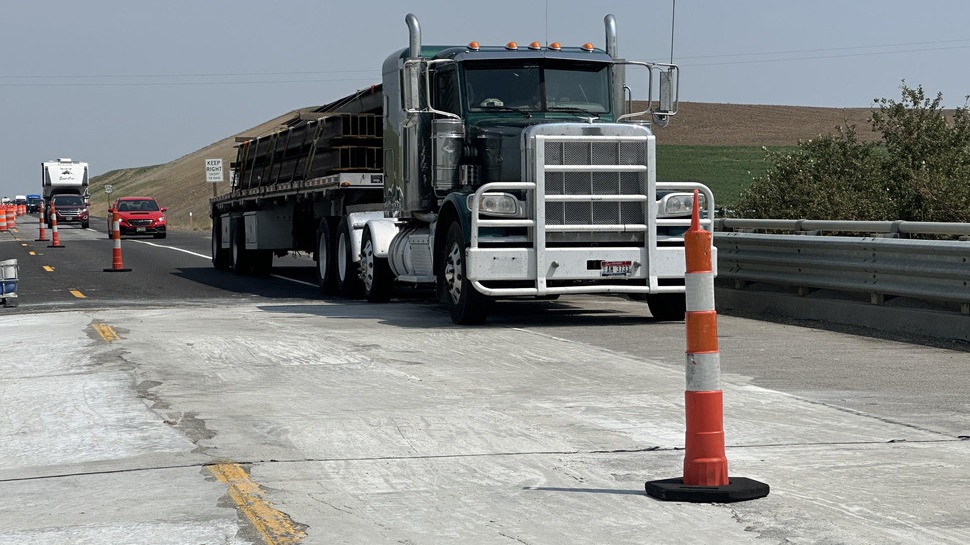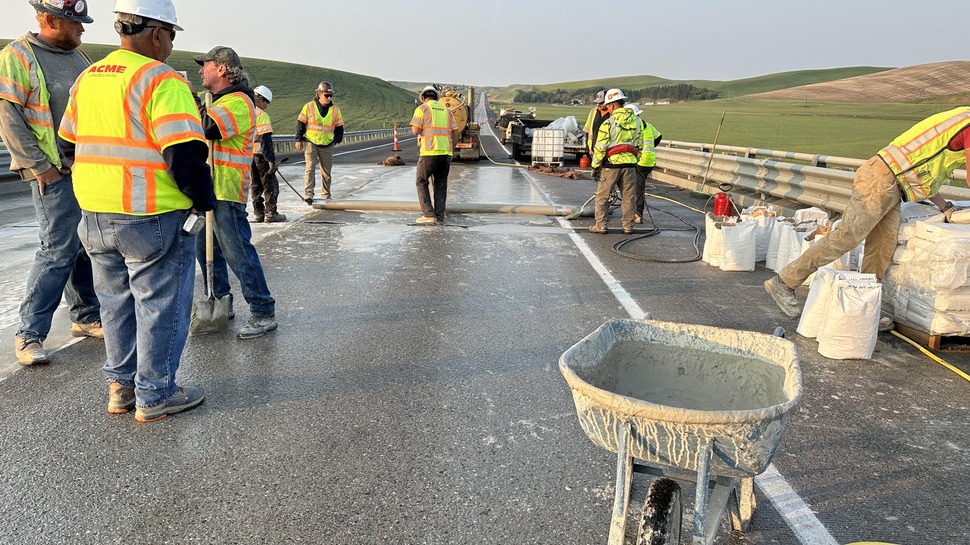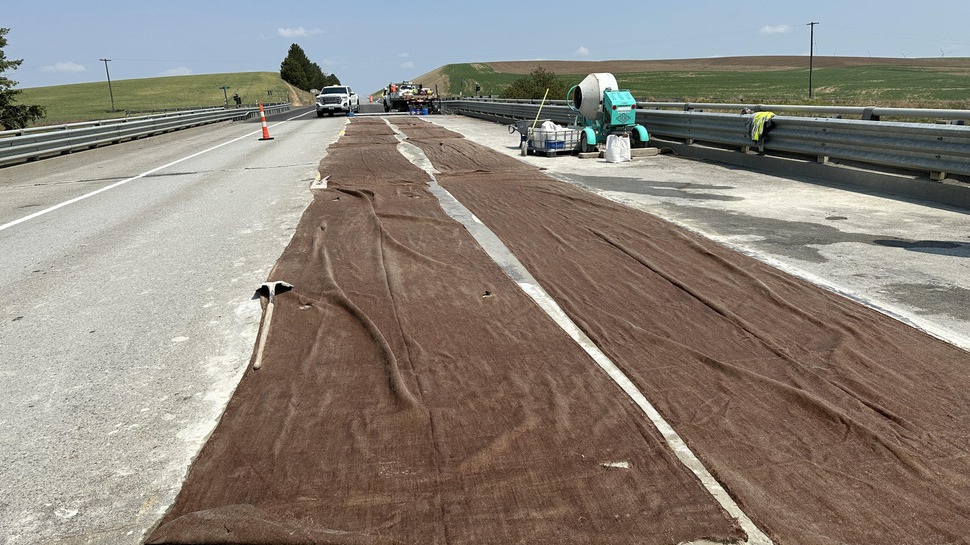
ACME Concrete Paving Inc. helps cities, counties and states throughout the Pacific Northwest build, preserve and rehabilitate hundreds of lane miles of concrete pavement every year. While new construction comprises much of the company’s work, a habit common to the region’s drivers generates plenty of repair and replacement work.
California, Oregon and Washington are bisected by mountain ranges where snow falls even in summer. California requires drivers to chain tires on some sections of I-80. Oregon and Washington passenger car drivers often chain their tires. In Washington, in Seattle as well as the mountains, heavy equipment and commercial trucks often sport studded tires.
While these measures maintain a vehicle’s grip on the road, over time they carve wheel-width grooves into concrete that can be more than 1 inch deep. The metal chains and studs abrade the pavement like sandpaper on wood, chipping out tiny pieces of the surface.
Surface damage ½-inch to ¾-inch deep is smoothed out with one or two passes with a diamond grinder, which over time reduces pavement thickness. Public agencies typically fill deeper ruts with polyester polymer concrete (PPC), a resin used neat or mixed with sand or aggregate, and grind the surface level after the material hardens.
This remediation method is more effective and less expensive than lane replacement or an asphalt overlay. However, after three to five years, the fill wears down and must be replaced.
In summer 2023, ACME crews were replacing pavement panels for the Washington State DOT (WSDOT) when supervisors saw an opportunity to try out a cementitious, single-component alternative to multicomponent PPC: Rapid Set® UHPC Mortar from CTS Cement Manufacturing Corp.
ACME has used Rapid Set® products since its founding 25 years ago, so managers knew the mortar would meet strength requirements as fast as PPC without adding accelerator. The company wanted to compare mixing, placement, workability and finishing with their process for rut remediation with polyester fill.
UHPC Mortar could conceivably be an easier-to-use and longer-lasting repair material for budget-conscious transportation departments.
Fluid But Sag-Resistant Pavement Fill
“We’d been trying to get this product down somewhere for about a year,” says ACME Grinding and Rehab Division Manager Kevin Schneider. ACME crews and equipment were replacing pavement panels on a two-lane highway near the rural town of Rosalia. Since he’d already paid for traffic control and the other usual project-related costs, the contractor offered to fill ruts on an adjacent reinforced concrete bridge deck for free. The state agreed.
The 150-foot-long bridge had wheel ruts roughly 3/8-inch deep and a 6% grade. That meant the job required a thin fill material that wouldn’t run.
“We did trial batching in our yard because we were concerned about the slope,” says Schneider. “We didn’t have any issues when we placed and screeded it.”
UHPC Mortar is a pourable blend of Rapid Set® calcium sulfoaluminate (CSA) cement, high-performance additives and high-density aggregate that reaches compressive strengths of 8000 psi (55.2 MPa) in four hours; 11,000 psi (75.8 MPa) at 24 hours; and 17,000 psi (117.2 MPa) at 28 days. The mortar reaches these strengths without fiber reinforcement, although fiber can be added per DOT specifications.
Because its core ingredient is Rapid Set® CSA cement, the mortar is naturally less permeable, lower-shrink and higher early strength than portland cement. Only water is required to achieve extremely high strength and abrasion resistance.
Temperatures were in the mid-50s when ACME closed the northbound lane and prepared the pavement surface by shotblasting the width of the rut fill placement, extending about 6 inches outside the fill area. Crews mixed 3.6 quarts of water per 60-pound bag of powder in a portable drum mixer (power-driven mechanical mixers such as a mortar, grout, pan or drill-mounted mixer are recommended), poured the mortar into the ruts from a wheelbarrow, and spread and consolidated it with a roller screed, feather-edging in some places. The placement was cured with wet burlap for a couple hours.
They repeated the process on the southbound lane about two hours later and ground the entire deck the next day.
The Rapid Set® CSA-based fill has weathered almost one full winter.
“The bond is excellent and there’s about the same amount of wear you’d see with polyester,” says Schneider. At 3/8-inch, the ruts were too shallow to extend the mortar. He’s looking for an application that would demonstrate how the material wears when aggregate is added to the mix. ACME may get that chance this spring on a Caltrans project near Truckee, Calif., where in 1846 the infamous Donner Party was marooned for the winter just below the summit of the Sierra Nevada mountains. This is the stretch of I-80 where California requires tire chains.
UHPC Mortar can be extended from 4 inches to 2 feet. To maintain the material’s high abrasion resistance, high-performance ¼-inch to 3/8-inch aggregate such as trap rock, emery or carborundum with an abrasion value of 15% or less per ASTM C131 is recommended.
UHPC Mortar can be used to fill connections between precast pavement panels and structural bridge elements like girders. Thin-bonded and regular pavement overlays and airport runways are also potential applications, as are industrial floors with extensive heavy traffic in a relatively small area, such as solid waste transfer stations and warehouse loading docks.
“We see a lot of potential uses for it in the rehab market,” says ACME President Robert Seghetti, a former president of the Inland Northwest Chapter of the Associated General Contractors of America (AGC) in Spokane, Wash. “We just need to get in front of more DOTs to get a track record with it and it’ll be adopted. The stuff really sticks; it’s impressive.”


